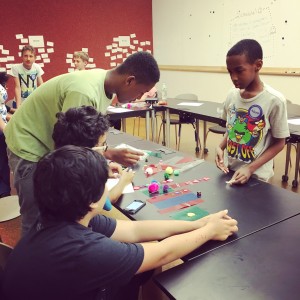
What does László Moholy-Nagy, a Hungarian artist active during the early 1900s, have to do with video game design? The National STEM Video Game Challenge and the Guggenheim Museum’s art education team partnered up last month to host a workshop that explored ways to apply Moholy-Nagy’s artistic process to the practice of game development.
In preparation for the workshop, the STEM Challenge team visited the museum to tour the current exhibition, Moholy-Nagy: Future Present. Working with the educators at the Guggenheim, we explored the best ways to teach Moholy-Nagy’s artistic philosophies.
Moholy-Nagy focused on process. He understood that in order to become a photographer he needed to understand light. Moreover, he focused on the intentionality of art creation— in his work, instructions were a part of the design. His work had process, and goals. He also experimented with the emerging technologies of his day.
Video game designers have to employ intentionality in game development. Each step taken towards the production of a game needs to be carefully thought out and considered within the larger context of the game. For example, when creating the rules of the game, you need to also consider the mechanics, goals, space, and components at play. These are the five elements of game design.
We chose a series of activities that highlighted the importance of intentionality within the design process. Students went on a special tour of the exhibit at the Guggenheim, with discussions about Moholy-Nagy’s work and practices along the way.

After the tour, students created games with just a bag of miscellaneous items, without any specific guidelines. The activity encouraged students to tap into their creativity while also considering the challenges of intentionality within game development. Finally, in the last hour students began to develop games on computers using Gamestar Mechanic.
Many of the students were surprised that a video game design workshop devoted only a quarter of the time to computer-based game development. But a lot of game development isn’t about the actual programming—though programming skills are important too. Moholy-Nagy spent years trying to understand light before he began taking profound photographs and creating his famous works with shadows, just as game developers need to spend time developing the elements of their game before going on to the programming phase.
 Sloane Grinspoon is an intern at the Cooney Center this summer, working with the National STEM Video Game Challenge team. She studies Psychology at Cornell University.
Sloane Grinspoon is an intern at the Cooney Center this summer, working with the National STEM Video Game Challenge team. She studies Psychology at Cornell University.

